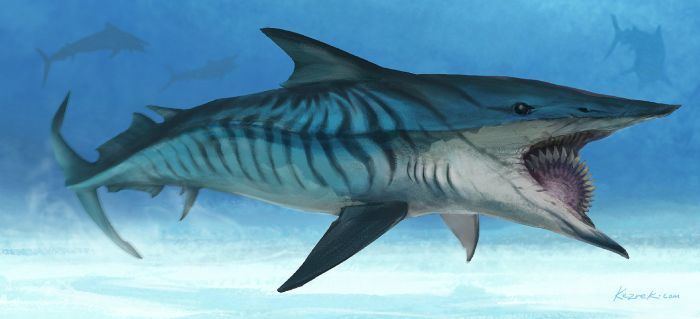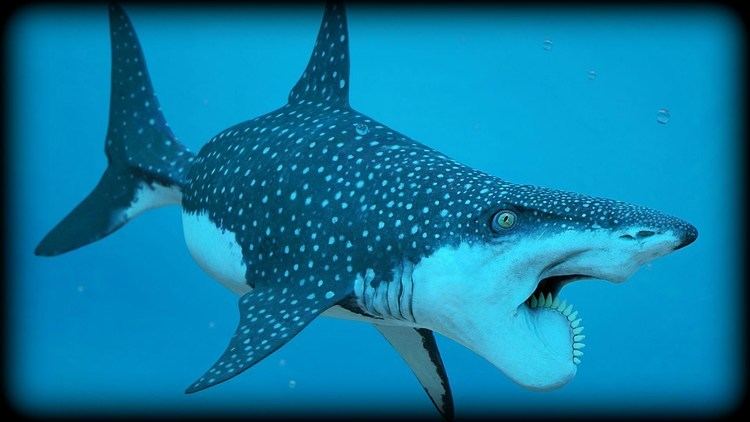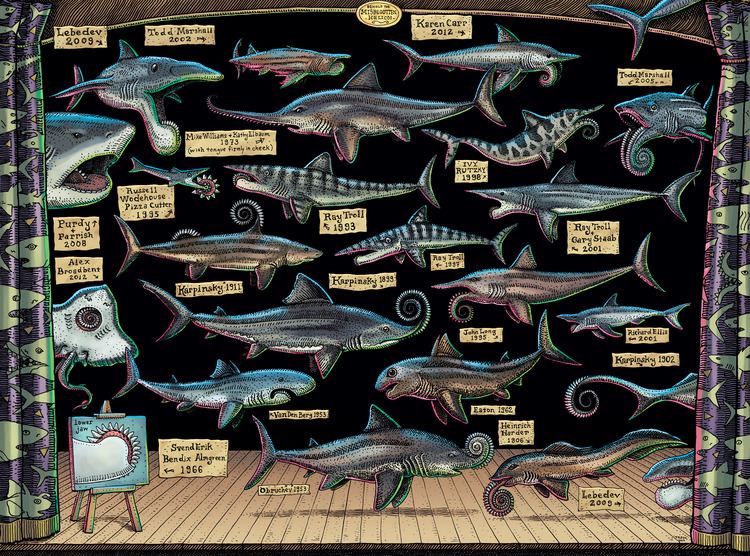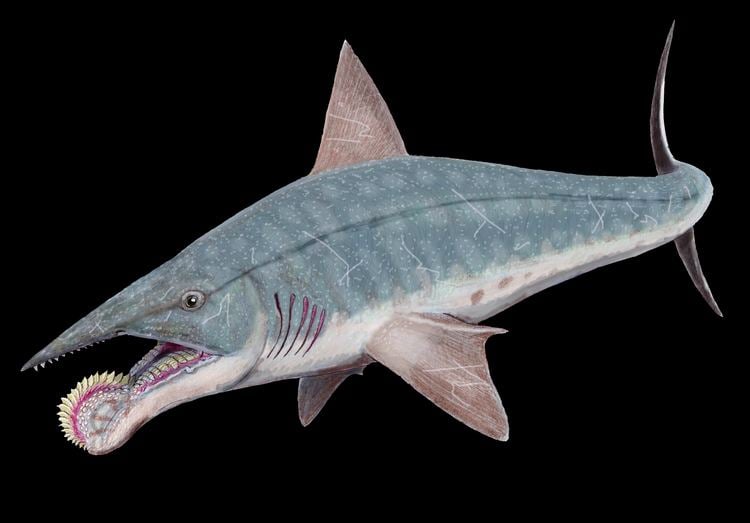Scientific name Helicoprion | Family †Helicoprionidae Higher classification Helicoprionidae | |
 | ||
Similar Edestus, Placoderm fish, Stethacanthus, Megalodon, Livyatan | ||
Prehistoric beasts helicoprion documentary
Helicoprion is a long-lived genus of extinct, shark-like eugeneodontid holocephalid fish. Almost all fossil specimens are of spirally arranged clusters of the individuals' teeth, called "tooth whorls"— the cartilaginous skull, spine, and other structural elements have not been preserved in the fossil record, leaving scientists to make educated guesses as to its anatomy and behavior. Helicoprion first arose in the oceans of the early Permian 290 million years ago, survived the Permian–Triassic extinction event, and eventually became extinct during the Early Triassic, 250 million years ago. Its name is Greek for "spiral saw". The closest living relatives of Helicoprion (and other eugeneodontids) are the chimaeras.
Contents
- Prehistoric beasts helicoprion documentary
- Size
- Nature of the tooth whorl
- Distribution
- H bessonovi
- H ferrieri
- H jingmenense
- H nevadensis
- In popular culture
- References

Size

Comparisons with other eugenodontids suggest that Helicoprion may have grown to 3–4 m (9.8–13.1 ft) long on average, with large specimens up to 7.5 m (24.6 ft). However, in 2011, a tooth whorl from a Helicoprion was discovered in the Phosphoria site in Idaho. The tooth whorl measured 45 cm (18 in) in length. Comparisons with other Helicoprion specimens show that the animal that sported this whorl would have been 10 m (33 ft) in length, and another, even bigger tooth whorl that was discovered in 1980s (but was not published until 2013) which the discoverers dubbed IMNH 49382 or "Boise" was discovered at the same site. The whorl is incomplete, but in life it would have 60 cm (24 in) long and would have belonged to an animal that possibly exceeded 12 m (39 ft) in length, making Helicoprion the largest known eugeneodont. The scientists have also discovered that the two specimens belong to an unknown species of Helicoprion.
Nature of the tooth-whorl

Until 2013, the only known fossils of this genus on record were their teeth, which were arranged in a "tooth-whorl" strongly reminiscent of a circular saw. As the skeletons of chondrichthyid fish are made of cartilage, including those of Helicoprion and other eugeneodonts, the entire body disintegrates once it begins to decay, unless exceptional circumstances preserve it. The tooth-whorl was not realized to be in the lower jaw until the discovery of the skull of a related genus of eugeneodont, Ornithoprion. The tooth-whorl represented all the teeth produced by that individual in the lower jaw; as the individual grew, the older, smaller teeth were moved into the center of the whorl by larger, newer teeth appearing. Models of Helicoprion'S tooth-whorl have been made. In the 1994 book Planet Ocean: A Story of Life, the Sea, and Dancing to the Fossil Record, author Brad Matsen and artist Ray Troll describe and depict an example. They say that no teeth were in the animal's top row besides the crushing teeth for the whorl to cut against. The two envision the living animal to have a long and very narrow skull, creating a long nose akin to the modern-day goblin shark. According to their studies, the fossils that have been found are essentially a growth ring, as each set of new teeth pushes the previous set into the whorl. The images that Troll has devised are an educated guess at best.

For over a century, where the tooth-whorl was in the lower jaw was not certain. Older reconstructions placed the whorl in the front of the lower jaw. A 2008 reconstruction, created by Mary Parrish under the direction of Robert Purdy, Victor Springer, and Matt Carrano for the Smithsonian, places the whorl deeper into the throat, although other studies did not accept this conclusion. A 2013 study based on new data places the tooth-whorl at the back of the jaw, where the tooth-whorl occupied the entire mandibular arch.

In the article, author Harry E. Wheeler describes another Helicoprion fossil, based on the species H. sierrensis, collected by J. H. Menke, that resides at the University of Nevada, W. M. Keck Earth Science and Mineral Engineering Museum in 1931. (The fossil is number 1002 and is currently on display in case 62.) According to Meller, Helicoprion’s mouth is its most distinct trait. The mouth consists of a whorl separated into three and a quarter volutions. The biggest diameter is about 170 mm (6.7 in). The whorls have a separation of about 1 mm (0.039 in) in the first volution, and it goes to about 8 mm (0.31 in) at the largest whorl displayed. The specimen has a total of about 32 teeth in the first volution, 36 in the second, and 41 in the last. The teeth at the end of the first volution are about 7 mm (0.28 in) long and are about 2.4 in (61 mm) width reaching about 40 mm (1.6 in) long and 9.5 wide at the end of the third. The teeth are symmetrically opposed to one another.

Additionally, other extinct fish, such as Onychodontiformes, have analogous tooth-whorls at the front of the jaw, suggesting that such whorls are not as big of an impediment to swimming as suggested in Purdy's hypothesis. While no complete skulls of Helicoprion have been officially described, the fact that related species of chondrichthyids had long, pointed snouts suggests that Helicoprion did, as well.
Distribution
Fossils of Helicoprion species first appear in Upper Carboniferous marine strata, proliferate greatly during the Permian, and eventually disappear during the Early Triassic. Fossils have been found in the Ural Mountains, Wandagee Mountain of Western Australia, China (together with the related genera Sinohelicoprion and Hunanohelicoprion), and Western North America, including the Canadian Arctic, Mexico, Idaho, Nevada, Wyoming, Texas, Utah, and California. Due to the fossils' locations, the various species of Helicoprion may have lived off the southwestern coast of Gondwana, and later, Pangaea.
H. bessonovi
Helicoprion was first described by Alexander Karpinsky in 1899 from a fossil found in Artinskian age limestones of the Ural Mountains. Karpinsky named the Type species Helicoprion bessonovi. Oliver Perry Hay originally described the species.
H. ferrieri
Helicoprion ferrieri was originally described as a species of the genus Lissoprion in 1907, from fossils found in the Phosphoria Formation of Idaho. An additional specimen, tentatively referred to H. ferrieri, was described in 1955. That specimen was found in Wolfcampian-age quartzites exposed on China Mountain, six miles southeast of Contact, Nevada. The 100-mm-wide fossil consists of one and three-quarters whorls and about 61 preserved teeth. Due to weathering, the rest of the fossil was lost and the preserved section is distorted from slippage of the host rock.
H. jingmenense
Helicoprion jingmenense was described from a nearly complete tooth whorl with four and a third volutions (part and counterpart) found in the Lower Permian Qixia Formation of Hubei Province, China. The specimen is very similar to H. ferrieri and H. bessonowi, though it differs from the former by having teeth with a wider cutting blade, and a shorter compound root, and differs from the latter by having fewer than 39 teeth per volution.
H. nevadensis
One of two Helicoprion species described by Wheeler in 1939, H. nevadensis, is based on a single partial fossil found in 1929 by Elbert A Stuart.
In popular culture
Helicoprion has appeared several times in public media, including books and television. Four notable television appearances include two episodes of Shark Week called "Prehistoric Sharks", "Jurassic Shark", and "Perfect Shark" (hosted by the late Mike deGruy) and the 43rd episode of River Monsters hosted by Jeremy Wade. The appearance of Helicoprion in "Prehistoric Sharks" and "Perfect Shark" was speculative, and many estimates of its size were made and the way the whorl was set into the jaw and what it ate were speculated. The episode of River Monsters, "Prehistoric Terror", was the first to show Helicoprion's appearance based on the skull found in Idaho in 2012, and through the researcher's speculation, was depicted in that episode as a hunter of soft-bodied prey, hunting, for example, spawning belemnites.
